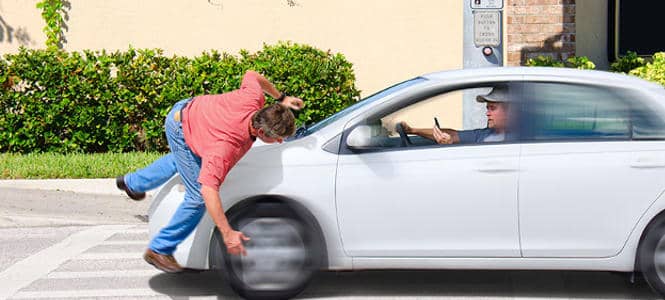

If you are a driver involved in a car accident, Hit & Run in California Vehicle Code requires you to identify yourself to all parties involved.
Any driver who drives off from the scene of an accident they were involved in without identifying themselves can be charged with a hit & run under either Vehicle Code 20001 VC or Vehicle Code 20002 VC.
Vehicle Code Section 20002 VC makes it a misdemeanor for the driver to leave the scene of an accident without identifying where the property was damaged.
Vehicle Code Section 20001 VC, on the other hand, makes it a misdemeanor or a felony in some circumstances for the driver to leave the scene of an accident where injury to another person occurred.
You should know that the amount of damage sustained, injury inflicted, who was at fault, or any other circumstances surrounding how the accident happened do not change your duty to stop and identify yourself to everyone involved.
Both Vehicle Code 20001 and Vehicle Code 20002 require the driver to do the following if they are associated with an accident:
If an accident involves a vehicle that was parked and the owner was not present. California Vehicle Code Section 20002 VC demands that the driver place an easily visible note with your identifying information, along with the address of the vehicle’s registered owner, if you do not own the car you were driving at that moment.
You must also place a call to the local police department and/or California Highway Patrol.
According to Vehicle Code Section 20002, a misdemeanor hit and run in California is a failure to stop and properly identify yourself after an accident that only results in property damage.
Common Examples of Misdemeanor Hit and Run in California
Charlie has committed misdemeanor hit and run in California. Once Charlie damaged the other vehicle, he had a duty to leave a note with his identifying information, and the information of the registered owner of the truck if Charlie did not own it. Charlie was guilty of hit and run when he left to run his errand, not just when he drove his truck away. It is irrelevant that Charlie intended to return.
Vehicle Code Section 20002 as a Misdemeanor
A person convicted for a misdemeanor hit and run in violation of Vehicle Code Section 20002 can be sentenced to:
Vehicle Code Section 20001 as a Misdemeanor

A hit and run in California can also be charged as a felony under California Vehicle Code Section 20001 VC, if:
What this means is that if you are in an accident where another person has been injured, and you do not exchange personal information as required above, then you may be charged with a felony under Vehicle Code 20001.
You should be aware that the prosecutor will have a great deal of discretion in how to charge a violation under Vehicle Code Section 20001 VC, and if the offense should be punished more severely for permanent serious injury.
Common Examples of Felony Hit and Run under Vehicle Code 20001
Because Charlie left the scene of an accident involving injury to a person other than himself, Charlie may be charged with felony hit and run Vehicle Code 20001 & 20002 in California. The prosecutor has wide discretion, based on the facts and circumstances, to decide if Charlie will be charged with a felony rather than a misdemeanor. Based on the severity of Dave’s injury, he suffered a large deep cut, this case would likely be charged as a felony. However, since none of Dave’s injuries were permanent, the increased penalties for serious permanent injury will not be an option.
Vehicle Code Sections 20001 VC and 20002 VC require property damage and/or injury to someone other than the person who failed to exchange the required information at the scene of the accident. If your car is the only one damaged or you are the only one injured. A hit and run charge under Vehicle Code Sections 20001 VC and 20002 VC may not be appropriate.
Perhaps you had loaned out your registered car to a friend or family member for the afternoon, and they committed a hit and run, or you happened to be in the car, accused of the hit and run, and the guilty party sped off so fast that a witness only saw you and mistook you for the driver.
If you fall into any of these categories, you should not be liable for charges under California Vehicle Code Sections 20001 VC and 20002 VC.
This is another valid argument the defendant can use to argue their charges under Vehicle Codes 20001 VC and 20001 VC. If the defendant reasonably believed their safety or life was in danger and had to flee the scene of an accident, they can use this to defend themselves in court.
We highly advise you to consult a licensed hit and run criminal defense attorney who will examine your case and determine what defenses apply to your particular case, and if there are alternatives they can use to help you avoid serving time in jail.
Sections 20001 and 20002 require property damage and/or injury to someone other than the person who failed to exchange the required information at the scene of the accident. If your car is the only one damaged, or you are the only one injured, a hit and run Vehicle Code 20001 & 20002 in California charge may not be appropriate. You should consult a licensed hit and run attorney who will examine your case and determine if any defenses apply in your case and if there are alternatives to serving time in jail.
If you or a loved one is being charged with a hit and run in violation of Vehicle Code Sections 20001 VC and 20002 VC, we invite you to contact us immediately for a free case review. Schedule an appointment to meet with us in person, or feel free to submit an evaluation online, and we will get in contact with you ASAP. Our experiences and assiduous Hit and Run, Criminal Defense Attorneys will be sure to fight until the end to reduce or drop your hit and run charges completely.
Call LAW MART for a FREE Case Review: 310-894-6440

Copyright © 2024 law – Powered by AmelCS